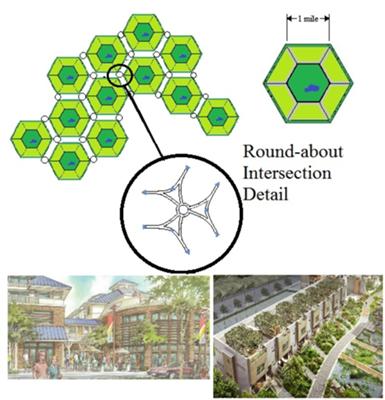Eco City
by Christopher Hedberg
(Chicago, IL (USA))

Quicky Graphic of Eco City
Last Reviewed: June 19, 2024
Visitor Writes: I've had this concept floating around my head for some time. It's really a half dozen of the 'Sustainable city' ideas all woven into one 'grand plan'.
It starts with Urban Gardens. But instead of a few vacant lots or tomato planters on balconies, the city is wrapped in over 1,300 acres of farmland. Enough area to feed about 12,000 people a 100% local and organic diet.
Each city block is no more than 1/2 mile long with extra wide sidewalks to encourage walking and biking instead of motorized traffic, but extra public transit routes added when the weather is less then desirable.
I envision all the homes made primarily from re-purposed shipping containers with green roofs. Locally and sustainably harvested wood and clay bricks right from the local soil can be added for facades and decor.
Leasing out some of the farmland for wind turbines will offset electricity costs, and methane reactors fed by community waste will provide gas for heating and municipal vehicles.
By requiring all local businesses to manufacture as much as possible, with only sustainable, recyclable or compostable materials and renewable power sources, the local economy can also be self sustaining, providing all necessary employment and not at the mercy of volatile markets.
As each city reaches its maximum sustainable population, the city expands through an "organic duplication" rather than "vertical and horizontal" urban sprawl, as described by Krier in The Architecture of Community.
Keeping the population density low will also make the city a far safer, healthier and more desirable place to live, with a large community park at the city center. If built, I believe this city would serve as the best example to other cities, as well as a model for all future Eco conscience construction.
Editors' Response: Thanks for sending along the interesting ideas, Christopher!
The Eco City idea echoes a number of urban theorists from the 20th and 21st centuries who believe that replicable pods are the best way to grow a city.
Also your idea seems to build on the greenbelt idea of surrounding the with a major amount of agricultural or forested land.
What our team found most interesting was the idea of requiring local businesses to use and re-use local materials. The question that visitors might want to discuss is how the Eco City would write laws that adequately would police such a matter.
Or would this community in fact be a co-op where people had to be voted in "membership" (either residency or business management)?
Although the U.S. has a now elaborate history of zoning regulations that regulate where businesses can locate, we don't know of regulations about where businesses obtain their materials. Nor do we know of rules that require all businesses to manufacture something, which is what your thought-provoking article seems to say at some points.
So the Eco City vision is well worth pursuing, and we'd like to hear from other readers what they think.
It won't surprise those who have read much on this site that we actually like density and verticality in cities.
However, we recognize a high percentage of the population wants to live more in horizontal space than vertical, and therefore would welcome the chance to help design and inhabit your Eco City.
Making and Keeping a Good Community > - City Planning >
- Best City Plan > Eco City
Comments for Eco City
|
||
|
||
|
||
|
||
Join GOOD COMMUNITY PLUS, which provides you monthly with short features or tips about timely topics for neighborhoods, towns and cities, community organizations, and rural or small town environments. Unsubscribe any time. Give it a try.